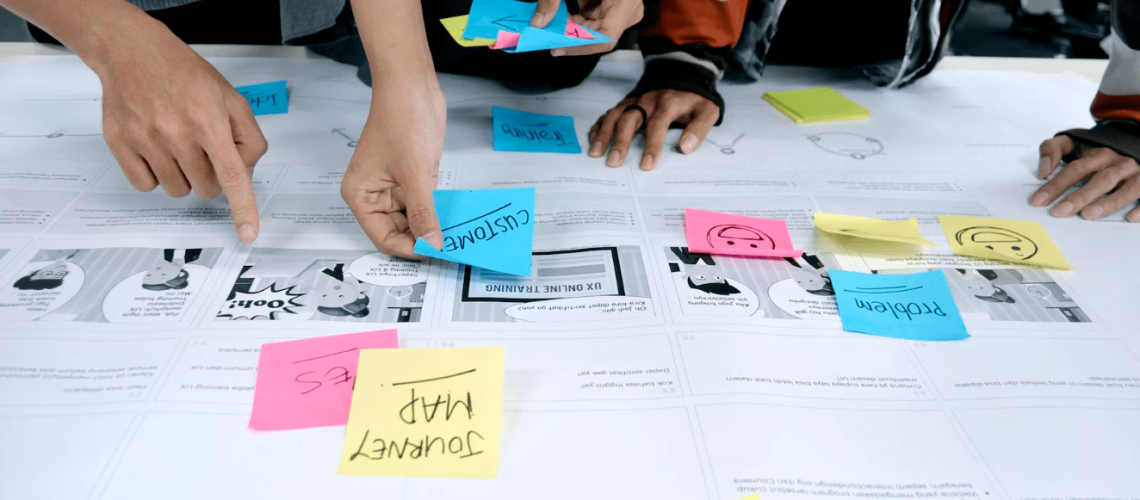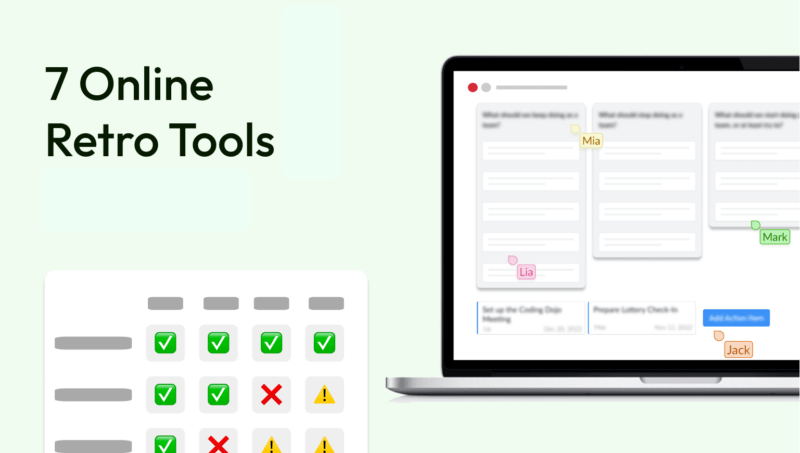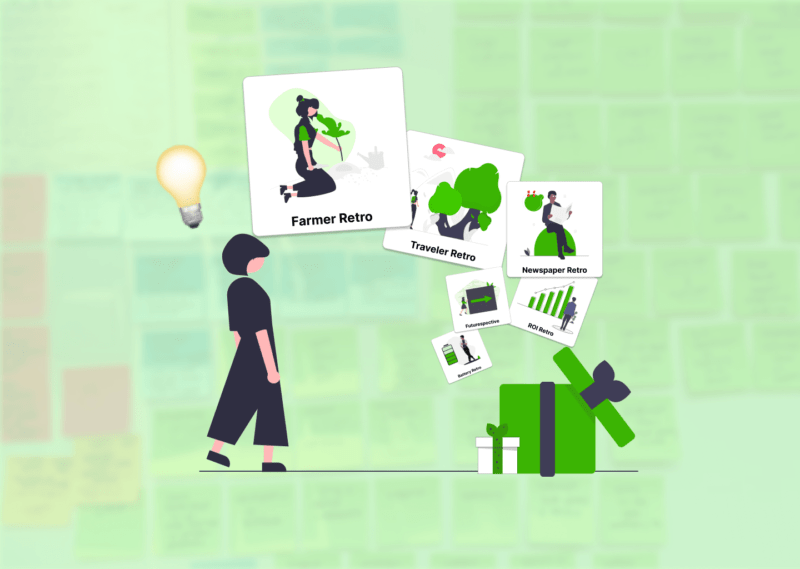Table of Contents
Are you looking for first-class examples & samples of retrospectives? – Then you've come to the right place, because in this article I'll give you lots of examples of simple retrospectives.
In total, there are more than 30 simple retrospective examples & samples that you can use as inspiration or try out directly if you are interested.
In addition to classic retrospective templates such as the "Keep Stop Start" or the "Mad Sad Glad" retrospective, I have also listed new types of retrospectives. These retros include, for example, the Tetris Retro, the Five Agile Values Retro or the Four Seasons Retros.
But before we look at the examples and samples of retros, let's take a brief look at what characterizes a successful retrospective method:
What makes great retrospectives?
Retrospective literally means "looking back". In agile methodology, this means looking back at a team's past work period and analyzing it.
It is easier to say that you review what has happened and learn from your mistakes and successes.
So it's no wonder that one of the first and most popular retrospectives is the "What went well" retrospective, which asks these three simple questions:
- What went well?
- What went not so well?
- How can we improve?
Simple and effective retrospectives are therefore characterized by the fact that they offer a framework of questions aimed at learning from the work of the past weeks. However, this can go far beyond the simple "What Went Well" method:
- You can take a more playful approach, for example: The sailboat retrospective
- You can expand the questions: The starfish method
- Or you can shed light on more specific aspects of the work: The battery Retro
The variety of examples and samples of retrospectives is almost endless.
However, a first-class retrospective involves much more than just a valuable retro method. That's why I've put together a few articles here to help you deepen your knowledge:
- An entry guide for retrospectives.
- How to define valuable "measures.
- Our full retrospective agenda.
- "Psychological safety" for agile teams.
- The best retro check-ins for any situation.
And now let's get started with the examples of retrospectives...
9 Simple retrospective Examples & Samples - the classics
Let's start with the "best" retro techniques from the agile world – or at least with the 9 most common ones:
Simple Retrospective Example & Sample #1
1. The "What Went Well" Retrospective 👍
The "What Went Well" retrospective is the most frequently used retro technique in our tool. It is simple and effective:
Open Feedback Questions
What went well?
What went not so well?
How can we improve?
Simple Retrospective Example & Sample #2
2. The "Mad Sad Glad" Retrospective 😯
The "Mad Sad Glad" retrospective technique has a similar pattern, but places more emphasis on looking at the emotions of the individual team members.
Open Feedback Questions
What made you mad? 😤
What made you sad? 😢
What made you glad? 🤩
Fun Retrospective Example & Sample #3
3. Start Stop Keep or Start Stop Continue 🔖
The "Start Stop Keep" retrospective technique is also known as the "Start Stop Continue" retrospective. I highly recommend making it a "Keep Stop Start" retro (pay attention to the order). This way you start the retro with something positive. This has proven to be a good start:
Open Feedback Questions
Keep: What should we keep?
Stop: What should we stop doing?
Start: What should we start doing?
Fun Retrospective Example & Sample #4
4. 4 L's Retrospective technique 📘
The 4 L's stand for "Liked, Learned, Lacked, Longed for".
Rumor has it that people can't agree on whether it's called the 4L Retrospective or the 4L's Retrospective.
By the way: You may notice from this retro that retrospective questions are also well suited for use in one-to-one discussions or coaching with employees. If you are also interested in this topic: Here you will find 129 one-to-one meeting (or appraisal interview) questions and Here are the 3 best one-on-one employee review tools in comparison.
Open Feedback Questions
Like: What did you like?
Learned: What did you learn?
Lacked: What did you lack?
Longed for: What did you long for?
Fun Retrospective Example & Sample #5
5. The Sailboat Retrospective ⛵️
The sailboat retrospective technique is one of the most popular symbolic retrospective techniques out there. I suppose it's because of the adventure that comes with a boat trip:
Open Feedback Questions
⚓️ Your anchor: What holds us back?
🦈🧊 Your shark/iceberg: Which dangers or obstacles approach us?
💨 Your tailwind: What drives us forward?
🏝💰 Your paradise: What achievement or milestones are we working towards?
Fun Retrospective Example & Sample #6
6. DAKI (Drop Add Keep Improve) Retrospective ✂️
DAKI stands for "Drop Add Keep Improve". A popular retro that is a simple acronym alongside KALM Retro (Keep, Add, Less, More).
(Want to take a look at its twin, the KALM Retro? The KALM Retro with examples)
Open Feedback Questions
Drop: What should we drop?
Add: What should we add?
Keep: What should we keep?
Improve: What should we improve?
Fun Retrospective Example & Sample #7
7. The Three Little Pigs Retro 🐷
A retro technique based on a fable. Here, the three little pigs build different shelters to protect themselves from the evil wolf. How stable are your performances?
Open Feedback Questions
House of straw: What do we do that is just holding together, but could topple over at any moment? 🌱
House of sticks: What do we do that is relatively stable, but could be improved? 🪵
House of bricks: What do we do that is rock solid? 🪨
Fun Retrospective Example & Sample #8
8th The Starfish Sprint Retrospective ⭐️
With its 5 questions, the starfish retro technique tends to take a little longer than other retrospective formats. It is ideal for small teams:
Open Feedback Questions
Keep: [Optional: Looking at the last sprint / weeks] What should we keep doing, keep as it is?
Stop: What should we stop doing?
Start: What should we start doing?
More: What should we do more of?
Less: What should we do less of?
Fun Retrospective Example & Sample #9
9. Thumbs Up, Thumbs Down Retro🤙
An agile retrospective technique that focuses entirely on appreciation:
Open Feedback Questions
What do you give a "thumbs up" to?
What do you give a "thumbs down" for?
Which new ideas do you have?
Who or what do you want to recognize, highlight positively?
Echometer Originals
Fun retrospective techniques your team has never seen before...
These were the most popular retro techniques and samples from the agile world. But who always wants to hold the same retro?
So here are some retrospectives that you probably haven't seen before. The "Echometer Originals":
Fun Retrospective Example & Sample #10
10. the meme retro 🤓
What used to be cartoons are now MEMEs. And with the birth of MEMEs, MEME faces were also born:
Open Feedback Questions
Me Gusta: What did you like about the last sprint?
4 Real: When did you feel really pranked in the last sprint?
I am watching you: What will you be on the lookout for in the future?
Fun Retrospective Example & Sample #11
11. The Mario Kart Retro 🚗
Not happy with your team's velocity? Then head to the race track and see what you can get out of it. This time it's both a "futurespective" and a retrospective:
As futurespective
What bananas on the track do we have to look out for?
What’s an upcoming shortcut we could take advantage of?
What powerup could we pick up to ensure our win?
As a retrospective
What shortcuts helped us win?
Which bananas did we slip on?
What was the powerup that gave us an edge?
By the way, if you want to develop your team holistically, then you also need to improve psychological safety in the team. In this video, our co-founder Christian explains 4 team and one-to-one exercises you can do to increase psychological safety.
Fun Retrospective Example & Sample #12
12. The role-playing game Retro 👨🏼💻
Are you longing for a level-up? Then you could look at everything more like a game: With each level (sprint), things get more difficult. But the character (our team) also develops its strengths in order to master the challenges:
Open Feedback Questions
What’s our superpower as a team?
What character class is the hero of the last sprint?
Looking at recent challenges: Which characteristics & skills should we level up as soon as possible?
What’s our next game milestone (e.g., villain to tackle)?
Optional: Who recently rolled a Nat 20 and saved the team?
Fun Retrospective Example & Sample #13
13. The Tetris Retro 👾
Still missing a puzzle piece for success? Tetris is a challenging arcade game with the aim of puzzling under pressure, so to speak. Sounds similar to work? It kind of is. The corresponding retrospective technique:
Open Feedback Questions
Which piece fit perfectly into the puzzle in the last sprint?
Which piece did not fit at all?
How many uncleared rows have already accumulated?
When was the last time we cleared multiple rows at once?
What new piece could we invent to fill a gap we have right now?
Echometer Originals
Work-Life Balance Retrospectives Samples
Hard work is not everything. This is exactly what you can express with his retrospective techniques.
How about a relaxed round around the campfire or an escape room as a team-building activity?
Fun Retrospective Example & Sample #14
14. The campfire retro🔥
You can relax around the campfire and let your mind wander.
But a fire in the office is not a good idea! But that's exactly why we developed the Campfire Retrospective:
Open Feedback Questions
Warm fire: What made you feel good in the last sprint?
Turned to ashes: What did not work as desired and crumbled to ashes?
The shooting star: What do you wish for the future?
Fun Retrospective Example & Sample #15
15. The theater retro 🎭
Sometimes work is like a theater. There is so much drama! But what role did we play in it?
Open Feedback Questions
Who was the (tragic?) hero in the last sprint and why?
At which point of the storyline did you get lost?
In which situation did you have stage fright?
Where would a prompter have been helpful?
Which role would you like to play in the future?
Sprint Retrospective Example & Sample #16
16. The escape room retro 🕵🏼
Escape rooms are a popular team building activity for a reason. They have just the right balance of "pressure" and "fun".
So if the team feels as if it is somehow stuck, it is worth breaking out of its own situation. Just like in an escape game.
Open Feedback Questions
What puzzles do we still have to solve?
Where are we running out of time?
Where could communication in the team have been better?
Which challenge did we master pretty well?
Sprint Retrospective Example & Sample #17
17. The surfer retro 🏄🏽♀️ 🌊
When you think of surfing, you quickly think of Hawaii, sun and flow.
But did you know that mankind's greatest achievements have all happened in a state of flow? Time to retrace it:
Open Feedback Questions
What made you fall?
When have you been able to show your skills?
What keeps you balanced?
How can you maximize the chances to catch the next wave even better?
Sprint Retrospective Example & Sample #18
18. the Michelangelo Retro 🧑🏾🎨 🖼
How can you ensure that your work becomes a masterpiece? Let's just ask one of the greatest artists of our time:
Open Feedback Questions
What is the big picture we are working on?
Which details should we focus on in the next weeks?
Where do we have difficulties finding the right color?
Which new brush should we use, which new approaches should we try out in the next few weeks?
Echometer Originals
A Retrospective For Every Season!
Spring, summer, fall, winter. There are not only the right clothes for different seasons and weather, but also the right retrospective techniques:
Sprint Retrospective Example & Sample #19
19. Want A Fresh Start? The Spring Retro 🌼
A new season is dawning and definitely one of the better ones. The days are getting longer and longer and slowly you can leave your jacket at home. At best, your team will blossom like the plants outside the windows. – Find out with these retro questions:
Open Feedback Questions
The first rays of sunshine: What makes us grow?
Pollen count! What should we shake off?
Not everything is a fresh start: what do we want to keep for the season?
Sprint Retrospective Example & Sample #20
20. Too Hot In The Office? The Summer Retro ⛱☀️
At its best, a sprint feels like what you imagine summer to be like. There's a positive vibe, the trees are blooming magnificently, everything is working smoothly. Nevertheless, there are some things that can make us sweat:
Open Feedback Questions
What was the ice cream, your favorite moment?
What made you sweat?
What could be a treat to cope with the summer heat in the future?
Agile Retrospective Example & Sample #21
21. Times Have Changed? The Autumn Retro 🍁
After summer inevitably comes autumn. A time of change, but also of new beginnings and gratitude. It's best to make sure you're prepared for all eventualities early on.
Open Feedback Questions
🌧🍂 On which slippery wet paths did we (almost) slip?
🌧🌈 What has been your rainbow moment (favorite moment of the sprint)?
🥜🐿 What do we need to prepare to get well through the winter? (Like squirrels prepare nuts for winter)
Agile Retrospective Example & Sample #22
22. It Runs You Ice Cold Down The Spine? The Winter Retro 🥶
Winter can be a long, hard and cold time. Or it can be a time of coziness and winter sports. Thus, it offers a lot of potential for creative questions that help you reflect on your agile sprint.
Open Feedback Questions
Snow: What have we almost forgotten under the snow blanket?
Ice: Where do we have to be careful not to slip?
Stove: What warms us up?
Anticipation: What can we hardly wait for?
Echometer Originals
How is your team doing?
Find out with Health-Check Retros!
One of the most important indicators of good performance in a team is team satisfaction. This is precisely why it makes sense to regularly check well-being in addition to project progress:
Agile Retrospective Example & Sample #23
23. Health Check Retro: Spotify Squad Health Check 👩🏻💻
The Spotify Health Check (based on the Spotify model) is one of the classics when it comes to frameworks to scale agile. The nice thing about it: The Spotify Health Check Retrospective can be carried out in tribes (several teams) as well as in individual teams.
Note: This retrospective format asks for agreement with the given Health Check items on a scale.
- Speed: We get stuff done really quickly. No waiting, no delays.
- Tech Quality: We’re proud of the quality of our code! It is clean, easy to read, and has great test coverage.
- Learning: We’re learning lots of interesting stuff all the time!
- Mission: We know exactly why we are here, and we are really excited about it.
- Other items (customizable)
Scrum Retrospective Example & Sample #21
24. Health Check Retro: The 5 Agile Values
The agile values and principles belong to the basics of a Scrum course. Only when you live up to them, you can reach higher agile maturity levels as a team. This health check helps you to reflect on the 5 agile Scrum values from a different perspective with your team - and to make them measurable. See below for an impression of the questions asked.
Note: This retrospective format asks for agreement with the given Health Check items on a scale.
- Courage: We value people showing courage.
- Respect: We value each other’s ideas, even when disagreeing.
- Commitment: Every team member is committed to follow through on what they have promised.
- Focus: We don’t allow ourselves to be distracted from reaching the sprint goal.
- Openness: We are open to constructive feedback and grow from it.
Echometer Originals
7 Performance retrospective methods
Many retrospective methods are variations on the "what went well" retrospective. But even though these variations create a sense of variety and have been proven to increase engagement, they do not provide many new insights. This is precisely why we have developed retrospectives that solve this problem.
Scrum Retrospective Example & Sample #25
25. Agile Delivery Retrospective ⚙️
Due to the massive cost savings currently affecting many companies, the topic of "Agile Delivery" is becoming increasingly important. Use this retro to check how your team is positioned in this regard.
If you want to find out more about this trending topic, take a look at this article: Increase your agility in 2024
Health-Check questions:
These questions are answered on a scale (1-5):
We get things done really fast. No waiting, no delays.
We are able to estimate exactly what we can deliver in a given cycle and with the given resources.
Our sprint results do not require any post sprint rework to be delivered.
We limit our 'work in progress' to be focused at all times.
Open feedback questions:
When did your ways of working create a suboptimal flow of work (e.g., policies are unclear, not suitable or not adhered to)?
When has our way of working worked well?
What are recent examples for an increment that wasn't working / shippable at the end of the cycle?
Scrum Retrospective Example & Sample #26
26. Team Commitments Retrospective 🤝
The current challenges require exceptional teamwork. Check whether your team is pulling together with this retro:
Health-Check questions:
These questions are answered on a scale (1-5):
As a team, we share a common understanding of what "good work" is.
Open feedback questions:
Handling of contradictory priorities: ‘When I encounter contradictory priorities, I …’
Communication of blockers: ‘When I am stuck on a task, I announce this by …’
Navigation of conflicts: ‘When I notice a conflict start to build up in our team, I …’
Scrum Retrospective Example & Sample #27
27th Psychological Safety Retro 🧠
Low-conflict collaboration is crucial, especially in tough times. To achieve this, however, everyone must have the confidence to talk about points of friction before they get out of hand. Having the security of always being able to speak out in a team is also known as "psychological safety". See where you stand on this topic:
Health-Check questions:
These questions are answered on a scale (1-5):
I regularly receive useful feedback on how good my performance is and how I can improve.
If a team member makes a mistake, they are not judged for it.
You're allowed to not know things in our team.
In conflicts, we talk on a factual level, so that no one feels personally attacked or judged.
Open feedback questions:
What else do we want to talk about?
Scrum Retrospective Example & Sample #28
28. battery retrospective 🔋
Difficult times also put a strain on personal batteries. It is particularly important now to keep an eye on the team's energy levels:
Open feedback questions:
How full is your personal battery as a percentage right now?
What has drained your battery recently?
What has recharged your battery recently?
What would help you to save energy over the next few weeks?
Scrum Retrospective Example & Sample #29
29th Future-Spektive (Future Retrospective) 🔜
In rapidly changing environments, you should not only reflect on what has happened, but also dare to look into the unknown. How do you want to act in the future?
Open feedback questions:
What is the most important milestone you would like to see us achieve as a team in the next week(s)?
Which hurdle should we focus on overcoming in the coming weeks?
What would you be particularly grateful for in the coming week(s)?
Scrum Retrospective Example & Sample #30
30th bottleneck retrospective ♾️
The days of an abundance of money are over. This often results in new bottlenecks to which work must adapt:
Open feedback questions:
Our bottleneck: What is the critical part in our structures and processes that determines how much we can achieve as a team?
What options are there for eliminating this one bottleneck?
Scrum Retrospective Example & Sample #31
31st OKR Retrospective 🏹
In this retrospective, you and your team can analyze exactly how well the OKRs have been defined and implemented:
Open Feedback Questions
Which key results were achieved?
Which key results were not achieved and why?
How can key results be better formulated in the future?
Did the achievement of the key results also lead to the achievement of the objectives (overarching goal)?
Are there better key results to achieve the actual objectives?
Echometer Originals
Something different for a change? - Crazy retro templates!
Not everything has to be taken seriously:
Scrum Retrospective Example & Sample #32
32nd Alien Invasion Retrospective 👽
What would you do in the event of an alien invasion? Probably it will never happen, but it is almost certain that other unforeseen things will happen. With this you can prepare your team top.
Open Feedback Questions
New species: what things have you encountered that you didn't expect?
Alien-Tech: What took your work to new heights this week?
Armageddon: Where have you seen your work go down?
Scrum Retrospective Example & Sample #233
26. Drum Roll... The Circus Retrospective 🤡
Clear the ring for the most varied retro, which also takes place in a tent:
Open Feedback Questions
Juggler: What tasks did you have to juggle that made you sweat?
Acrobat: What helped you to align yourself more flexibly?
Magician: What would you most like to conjure up that has been missing so far?
Retrospective Examples & Samples - Conclusion
With all these retrospective samples and examples, you're sure to find the right sample for your next retro. If not, we have even more in our retro board software tool Echometer.
Retrospective Templates: Some Final Notes
If you still have retrospective examples or ideas for an agile retrospective template or want to give us feedback... – just write to us.
And if you're looking for a free online retro board software for retrospectives, you may have seen that Echometer is just that. Have fun trying out the different retro templates in our tool
Most Agile Coaches and Scrum Masters run in circles...
...fixing superficial symptoms. Time to use psychology to foster sustainable mindset change.
















